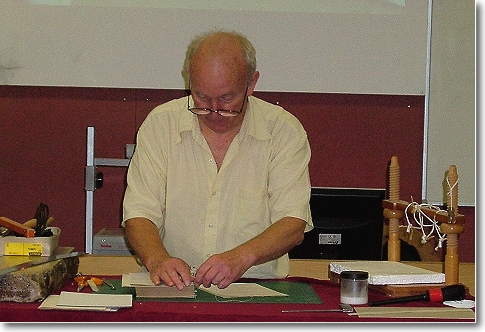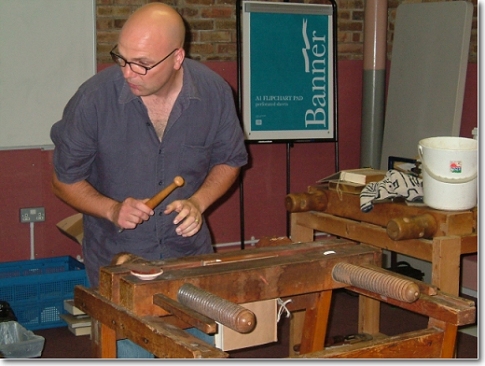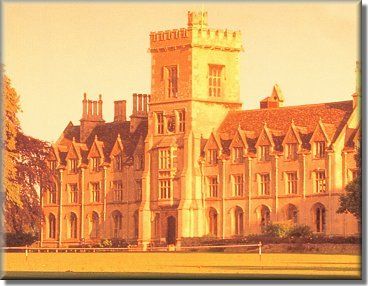
Volume 22 - Autumn 2006
Fast Forward
by Dr. Clive Owen
On the 2nd and 3rd of September 2006, the third annual bookbinding forum took place at the Royal Agricultural College, Cirencester. The event was organised by John Jameson and Lester Capon, in association with J. Hewit and Sons Ltd. By common agreement, this was the best event so far, with a feast of practical information and first-class demonstrations provided over the two days.
John and Lester are a good 'double act', with many years bookbinding experience between them. They are often able to provide alternative approaches to specific problems in bookbinding, and have the ability to teach in an informal and friendly way, encouraging people to ask questions at each stage of the demonstration.
John and Lester started Saturday's session with a demonstration of the complete forwarding process from the initial pulling, and separation of sections; through to gluing-up, rounding and backing, board make up and attachment, spine lining and making hollows, different sorts of endpapers, ploughing, and finally sewing a two-colour headband. The logic behind this demonstration, as John explained, was that few beginners in bookbinding get the chance to see the complete forwarding process in sequence, especially how the various stages link together to produce a book ready for finishing.
 John
Jameson in Action
John
Jameson in Action
In addition, both John and Lester included a comprehensive demonstration of various endpaper constructions, starting with the inclusion of loose guards on the first and last sections of the text block before sewing. This has the advantage of making the endpapers lie perfectly flat when opened (unlike tipped-on endpapers). The demonstration moved on to various 'made' endpapers using coloured and marbled papers, and finally a leather-jointed endpaper that is sewn through the middle of the first folio.
At 4pm on Saturday we were introduced to Edward Bayntun-Coward, the proprietor of the famous Bayntun-Riviere bindery in Bath. Edward gave a fascinating insight into the work of the bindery, including the discovery of a large cache of antique finishing tools, totally new and unused, discovered in the workshop. Bayntuns already boasts an incredible 15,000 finishing tools, which must be one of the largest collections in the U.K.
The after dinner speaker on Saturday night was Dominic Winter the well-known book auctioneer, who gave a talk entitled 'Tales from the Auction Room'. Dominic is a natural and engaging speaker, who spoke without notes, but managed to captivate us with tales of finding rare, and previously unknown, William Blake watercolours, and an extremely rare and valuable early photographic album recovered from the Council rubbish tip! Finally, the group gravitated to the bar where old acquaintances were renewed and new friendships made.
Sunday morning provided one of the highlights of the weekend with an expert demonstration of edge-gilding by Don Alexander of Bayntuns. Don is a professional guilder and a superb demonstrator, who managed to enthuse even those who had not yet launched themselves in this direction.
Don emphasised the importance of preparation, stating that efforts made in preparing the edge will be repaid in the quality of the finish. Firstly, the work is set up by placing the book block between wedge-shaped boards. In order to get the surface as flat as possible, the block should be raised a tiny bit above the boards to allow for sanding. If the book is made from poor quality, highly absorbent, wood-pulp paper (typical of books printed in the 1930s), then it might be worth applying French chalk to the block by fanning the pages back at an angle of 45 degrees to apply the chalk, then turning the block around and repeating from the other side.
Sand the edge with sandpaper wrapped around a wooden block to eliminate any visible lines (Don uses grades P180, P200 and P300). Then apply bole before scraping to expose irregularities in the edge.
 Don
Alexander demonstrating edge-gilding
Don
Alexander demonstrating edge-gilding
The scrapers at Bayntuns are made from old saw blades which have been given a burr on one edge. Concave edges can be sanded using cardboard tubes wrapped in sandpaper and Don has a variety of these in different sizes.
Armenian bole is basically a red clay which is mixed with paste and a small amount of water, which is then mixed to a creamy consistency (some finishers at Bayntons use a PVA/paste mixture). The mixture should be still liquid but fairly viscous.
Apply the bole with a small sponge. This process will expose all flaws. Brush with a small shoe brush with fairly stiff bristles. The aim is to polish to a shiny surface, ''a shiny bole will lead to a shiny edge''. When polished with a dog-tooth burnisher the edge quickly polishes up. Bees' wax is added to the burnished edge with a soft cloth and this is further burnished to produce a very shiny surface. (At this point in the demonstration someone asked whether applying wax to the bole before gilding might cause problems with the gold failing to adhere to the edge. Don replied that, provided the surface was highly polished with a dog-tooth burnisher, no problems should be encountered).
One cup of glaire is added to a pint of cold water and then strained through mull (a drop of white vinegar can be used to prolong the life of the glaire).
Don recommends using 23.5K gold. The gilders tip is then run through the hair to pick up sufficient grease to pick up the cut gold leaf section from the cushion.
Glaire the edge and 'plop on' the gold with the guilders' tip, and then 'huff' it on to the glair using the breath. Only glair the area you are gilding, and you can 'tap' the gold onto the glaire with the guilders' tip.
Each section of gold is slightly overlapped (a hair's breadth). If you are not satisfied with the first quality you can re-glaire and add more gold.
Use the 'huff test' to see if the gold is dry. If the gold fails to clear immediately when huffed on you need to allow more time for it to dry. Each edge must be finished completely before the next edge is attempted.
Next the edge is rubbed down through paper. Apply a smear of wax to a sheet paper on the top and burnish the edge through the wax side of the paper. The wax surface ensures the burnisher does not snag the paper.
Remove all loose gold because this can scratch the surface when burnishing. The pressure on the burnisher is increased as the work progresses.
The 'gauffered' edge. Gold is applied to the edge but is not burnished. Finishing tools are applied to the gold cold, and impressed into the gold before burnishing. A pattern is first worked out for the edge design on thin paper. This is then taped to the gilding boards as a guide for the tooling. Don produced a very pleasing effect using a diamond pattern based on 45 degree lines across the edge using a patterned roll. A centre tool was then added to finish the pattern. More pressure can be applied to cold tools than when they are heated, and Don appeared to press quite heavily on his tools during the demonstration. The final effect was superb.
Next was a bookbinding forum in which an expert panel assembled to advise on difficulties people had experienced when restoring or re-binding their books. Various questions were taken from the floor and we were then shown several exhibition bindings of very high quality.
After lunch, Stuart Brockman gave an expert (and effortless) demonstration of full-leather covering. Stuart demonstrated a modern, goatskin binding with cushioned boards that were attached by linen tapes tied through the boards, and then a more traditional full calf binding, whilst contrasting the two techniques. Stuart also had some of his commissioned bindings for us to examine and these were truly the work of a master binder.
Finally, the weekend ended with an auction of various bookbinding tools and materials. All in all, an excellent weekend in pleasant and comfortable surroundings. Thanks to John and Lester for all their hard work.

Dr. Clive Owen - Clive has have been an avid book collector for many years; especially Victorian and Edwardian pictorial bindings as well as fine leather bindings, and came to book binding by way of necessity, since many of these books needed repair. He is a keen and enthusiastic amateur binder whose only regret is that he didn't start binding years earlier.
